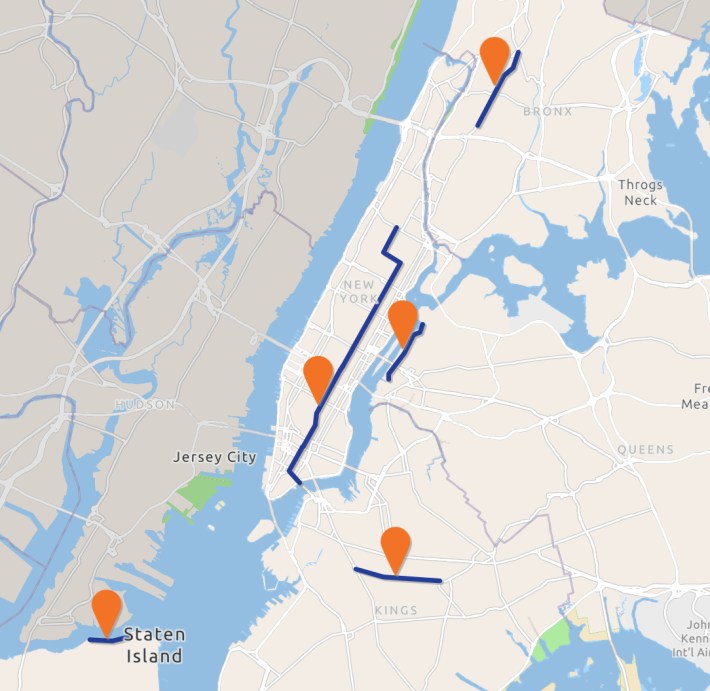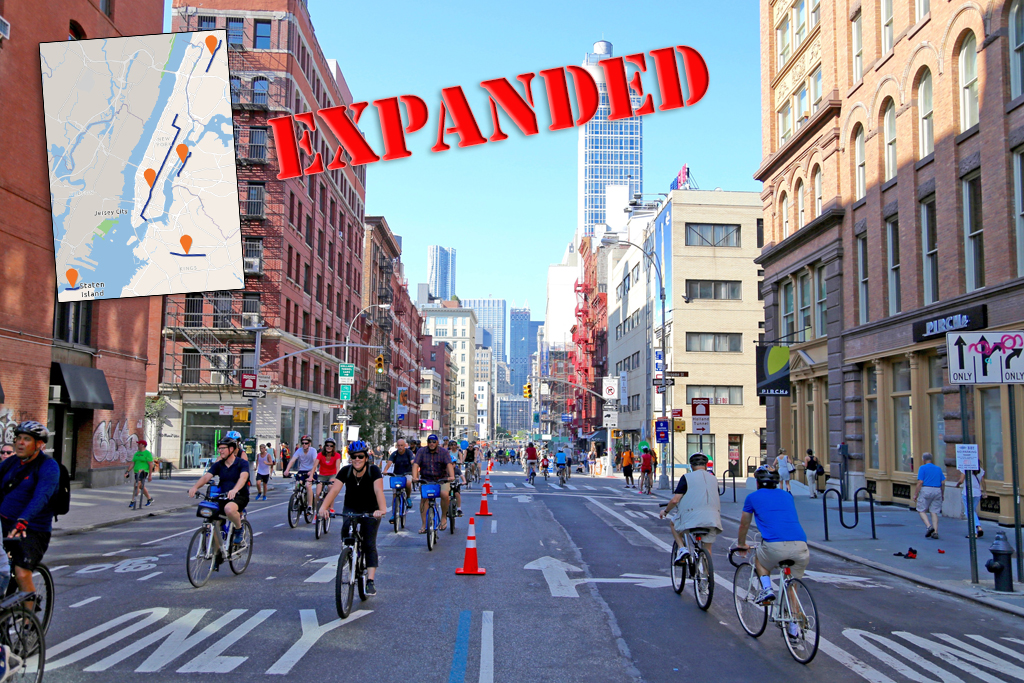As the Beastie Boys said — you need Brooklyn, Queens, the Bronx and Staten to make it happen.
New York City's car-free "Summer Streets" program will extend beyond its traditional three Saturdays in Manhattan to all five boroughs for the first time this year, Mayor Adams said on Monday, though the hugely popular program still won't go past the early afternoon.
"This is a five-borough city and we are now saying the Summer Streets program is going be a five-borough initiative. Everyone deserves to enjoy that," Adams said at a press conference in Long Island City.
The program will liberate streets from cars on five Saturdays in July and August from 7 a.m.– 1 p.m., at the following dates and locations:
- July 29: Queens on Vernon Boulevard, between 30th and 44th Drives; and Staten Island on Richmond Terrace, from York Avenue to Bard Avenue
- Aug. 5, 12, and 19: Manhattan from the Brooklyn Bridge to 125th Street in Harlem, largely on Park Avenue and connecting streets like Lafayette Streets and Adam Clayton Powell Boulevard
- Aug. 26: Brooklyn on Eastern Parkway from Grand Army Plaza to Buffalo Avenue (the same route as the West Indian Day Parade); and on the Bronx’s Grand Concourse, from East Tremont Avenue to Mosholu Parkway
Altogether, the program will comprise about 17 miles of city streets, by DOT's count, and basically double the miles of car-free space from last year's Summer Streets, including both the outer boroughs and an extension of the Manhattan open street north of 109th Street to 125th Street. Half a million people participated in last year's three Manhattan Summer Streets weekends, according to DOT Commissioner Ydanis Rodriguez.

Borough presidents Antonio Reynoso of Brooklyn and Donovan Richards of Queens previously called on City Hall to bring the 15-year-old program to their sections of the city, which are the most populous and the largest by area, respectively.
Speaking alongside Adams on Monday, Reynoso said he was pleasantly surprised by the news, and praised the mayor for not just symbolically choosing small dead-end streets.
“They didn’t choose a random street that no one cares about — they put it on Eastern Parkway," the Brooklyn beep said. "It’s really sending a message to folks how important this is and the value of it.”
The program mimics similar efforts in cities abroad, but still has a long way to go to match the heft of those cities' efforts. In Bogotá, Colombia, for example, officials bar cars from nearly 80 miles of roads every Sunday and on holidays from 7 a.m. to 2 p.m.
Adams on Monday said he was open to expanding the program's hours beyond 1 p.m., but said doing so had to be balanced with "public safety." The city stations NYPD cops along the route — a costly proposition, especially on a weekend when many officers are working overtime.
“There’s a balance, public safety is always a prerequisite in this city,” Adams said in a response to a question by Streetsblog. “We would like to go next year, we can scale up better and more hours.”
DOT in the past allocated about $500,000 to produce Summer Streets, which includes a wealth of programming like basketball games, workshops, marching bands, and band performances. This year the agency plans to earmark $1.5 million for the day’s events excluding NYPD and DOT staffing.
Advocates have proposed the city stretch its resources further by closing streets to cars for more hours without so many events — just keeping up barriers the way it does on Open Streets, but DOT spokesman Vin Barone said Summer Streets requires personnel “beyond lighter-touch barrier deployment.”
Reynoso and Richards had also proposed connecting the Summer Streets to each other, making for one, multi-pronged car-free corridor across the river.
DOT chose popular corridors that are easily accessible, while also trying to minimize impact on MTA buses, Barone said.
The expansion could galvanize support to run Summer Streets longer into the day, according to one open space booster.
“We have Vernon Avenue this year, what could it look like all day long,” said Jackson Chabot, director of advocacy at Open Plans, which shares a parent organization with Streetsblog.
“The framework is there, the bones are there, and now maybe it’s adding meat to the bones from this year, and little by little we’re building it out, and then next year, perhaps it’s supercharging it."






